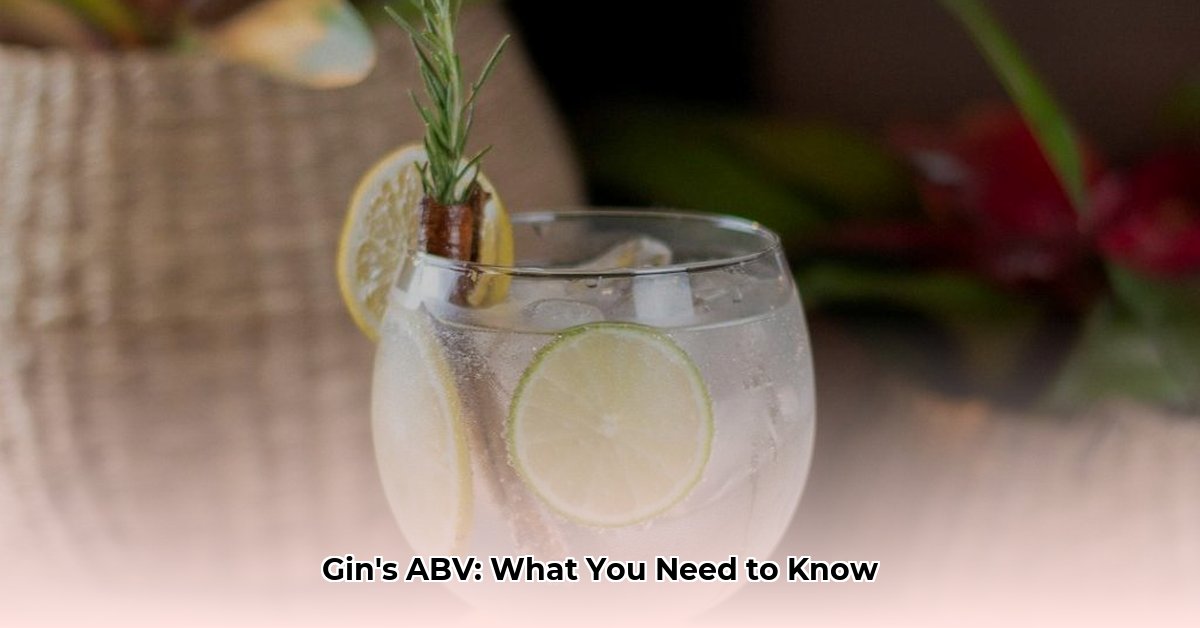Gin, a spirit celebrated for its botanical complexity, offers a diverse range of alcohol by volume (ABV). This comprehensive guide explores the nuances of gin ABV, from its fundamental definition to its profound impact on taste and mixology. Whether you’re a seasoned gin enthusiast or a curious newcomer, understanding ABV unlocks a deeper appreciation for this versatile spirit.
Decoding ABV in Gin
What exactly does “ABV” on a gin bottle signify? ABV stands for Alcohol By Volume, representing the percentage of alcohol within the total volume of the spirit. For instance, a gin labeled 40% ABV contains 40% pure alcohol. This seemingly simple number plays a crucial role in defining the gin’s character, influencing its taste, mouthfeel, and how it interacts with other ingredients in cocktails. In the US, you might also encounter the term “proof,” which is simply double the ABV. Thus, an 80-proof gin equates to 40% ABV. This system, with historical ties to testing alcohol strength by ignition, provides another way to gauge alcohol content.
Typical ABV Range: Finding the Sweet Spot
The majority of gins fall within the 37.5% to 50% ABV range. 40% ABV is a commonly encountered percentage, often serving as the legal minimum in many regions, including the United States. However, the world of gin offers remarkable diversity, with craft distilleries pushing boundaries and exploring higher ABV expressions.
The Art of Distillation & ABV Control
Distillation, the alchemical process of transforming fermented botanicals into gin, is pivotal in determining ABV. Distillers act as flavor architects, meticulously adjusting the alcohol content during and after distillation to achieve the desired balance. They carefully calibrate the concentration of juniper, citrus peels, and other botanicals, ensuring their harmonious interplay. After distillation, the gin’s ABV is fine-tuned by adding distilled water, carefully lowering the concentration to the target percentage. This precise control allows distillers to create gins with distinct flavor profiles, ranging from smooth and subtle to bold and intense.
Gin ABV by Brand: A Comparative Glance
This table offers a quick reference for the ABV of various popular gin brands. Remember that ABV can sometimes vary slightly based on region and specific bottlings, so checking the label on your bottle is always advisable.
| Gin Brand | Alcohol By Volume (ABV) |
|---|---|
| Aviation Gin | 42% |
| Beefeater London Dry Gin | 45% |
| Bombay Sapphire | 47% (US), 40% (UK) |
| The Botanist Islay Dry Gin | 46% |
| Ford’s Gin | 45% |
| Hendrick’s Gin | 44% |
| Hayman’s Old Tom Gin | 40% |
| Monkey 47 Dry Gin | 47% |
| Plymouth Gin Navy Strength | 57% |
| Sipsmith London Dry Gin | 41.6% |
| Sipsmith Sloe Gin | 29% (Note: Sloe gin is a liqueur) |
| Tanqueray London Dry Gin | 47.3% |
| Sipsmith V.J.O.P. | 57.7% |
| Blackwood’s Vintage Dry Gin | 60% |
| Strane Uncut London Dry Gin | 76% |
(Information collected on October 26, 2023. Keep in mind that ABVs can sometimes vary slightly, so always double-check the label on your bottle.)
ABV’s Influence on Flavor: A Matter of Balance
ABV significantly impacts a gin’s flavor profile. Higher ABV gins often exhibit a more intense, pronounced botanical character. The higher alcohol content can amplify the juniper and other aromatics, creating a bolder, more robust flavor experience. Conversely, lower ABV gins may present a smoother, gentler profile, allowing subtler nuances to emerge. This delicate balance allows for a wider exploration of flavor, catering to diverse preferences. Some research suggests that higher ABVs can create a “hot” sensation, a warming feeling in the mouth, which some drinkers find appealing.
ABV in Mixology: Crafting the Perfect Cocktail
When mixing cocktails, a gin’s ABV becomes a crucial consideration. A higher ABV gin can stand up to stronger mixers and maintain its presence in complex recipes. In contrast, a lower ABV gin might be a preferable choice for lighter, more delicate cocktails where balance is paramount. Choosing the appropriate ABV ensures that the gin complements, rather than overpowers, other ingredients, resulting in a harmonious and enjoyable drink.
Exploring Navy Strength Gin: A Historical Powerhouse
Navy Strength Gin, with its historically high ABV of 57% or more, offers a unique and powerful experience. Its origins are linked to the British Royal Navy, where, according to legend, the high alcohol content was essential to ensure the gin remained flammable even when mixed with gunpowder. Contemporary Navy Strength gins retain this robust character, delivering an intense flavor that appeals to those seeking a bolder gin experience.
The Rise of Lower-ABV Gins: Mindful Moderation
In response to the growing trend of mindful drinking, lower-ABV gins are gaining popularity. These lighter options provide the complex botanical character of gin without the higher alcohol content, offering a refreshing and balanced experience for those seeking moderation.
Responsible Enjoyment: A Word of Caution
While exploring the world of gin ABV is an enriching experience, responsible consumption is crucial. Understanding ABV empowers you to make informed choices, appreciate the nuances of different gins, and savor their complexities in moderation. Always be mindful of your limits and adhere to local regulations regarding alcohol consumption.
Disclaimer: Please drink responsibly. Be aware of and adhere to local laws regarding the purchase and consumption of alcohol.
- Lunch Box That Fits Bento Box Neatly for Daily Use - December 5, 2025
- Japanese Lunch Bag Does Double Duty as Bento Carrier and Tote - December 4, 2025
- Your Perfect Bento Box Bag For Fresh And Tidy Meals - December 2, 2025










